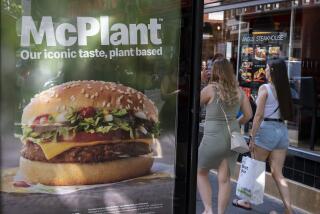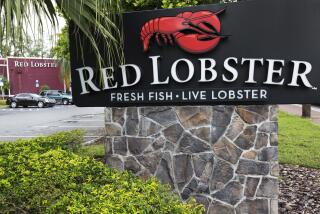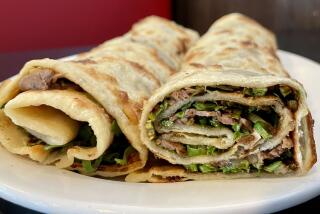Where’s the Beef Bowl, Japan Asks
- Share via
TOKYO — A top politician mourned its passing and a truck driver started a brawl when his order was refused. Office workers and laborers mobbed restaurants at lunchtime for a final mouthful.
The cause of the fuss? The Japanese beef bowl.
Tokyo’s 2-month-old ban on American beef imports -- because of fears of mad cow disease -- hit hard at the Japanese lunchtime crowd in the last few weeks as restaurants serving the cheap and filling “gyu-don” beef and onions on rice started running out of meat.
The most popular of the eateries, Yoshinoya, dealt the biggest shock, announcing that it would serve its final beef bowl Feb. 11, prompting a mad “beef rush” of 2 million customers -- double the usual -- at its 900-plus outlets. The media followed the mob, showing live footage on TV of hungry office workers giving melancholy elegies to a favorite meal of the Japanese everyman.
“It’s sad to see something that’s familiar disappear,” government spokesman Yasuo Fukuda said.
This country is the most lucrative overseas market for American beef -- it bought about $1 billion worth in 2002 -- and much ends up in “gyu-don” bowls.
Japan and about 30 other nations halted imports of American beef in December after a case of mad cow disease was discovered in Washington state. It is calling for stricter U.S. measures to stop the disease’s spread.
In the meantime, a staple of the middle-class lunch crowd is fading away.
Low-cost eateries like Yoshinoya -- which relies on U.S. suppliers for 99% of the beef used in its trademark dish -- have been unable to find a satisfactory alternative to American meat. Gyu-don lovers say Australian beef has a different taste.
The beef bowl is a natural favorite for those in search of a quick, inexpensive lunch, particularly after a decade-long economic slowdown has eaten away at Japanese wallets.
Servings of gyu-don -- often ordered by buying a ticket from a vending machine and handing it to the waitress -- start about $2.50.
“I used to eat frequently here because it’s cheap and good,” said Hirokazu Takemoto, an office worker who had just tried Yoshinoya’s new curry rice bowl -- one of the items introduced to replace gyu-don. His assessment? “It was OK.”
Some of the uproar turned violent. A drunken truck driver started banging on the counter of a Yoshinoya in Ibaraki, north of Tokyo, Feb. 11 when he was told that all the gyu-don was gone, then assaulted two customers who tried to calm him.
Even U.S. Trade Representative Robert B. Zoellick, who was in town, noted the fuss.
“When I next return, I would like to be able to come to the beef bowl and try what sounds like a very tasty product,” he said after talks with Japanese officials. “But that depends on Japan reopening its market.”
Most Japanese consumers seem to think that may take awhile.
In Tokyo’s busy Shimbashi business district, Masao Hashimoto, a construction worker, stopped by another chain, Matsuya, days before it stopped serving beef last weekend.
“I thought I better go one last time. It’s good stuff,” he said, smacking his lips.
Asked about alternatives, such as the McDonald’s down the street that uses Australian beef, Hashimoto was skeptical.
“It’s not quite the same, is it?” he said.
More to Read
Eat your way across L.A.
Get our weekly Tasting Notes newsletter for reviews, news and more.
You may occasionally receive promotional content from the Los Angeles Times.










